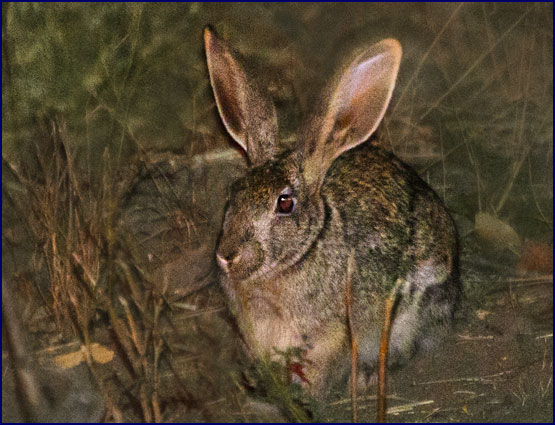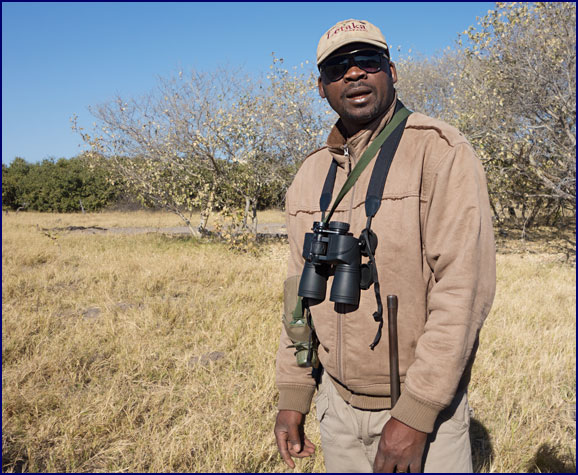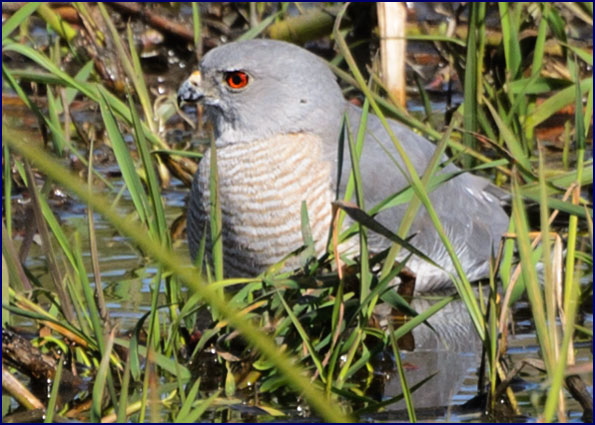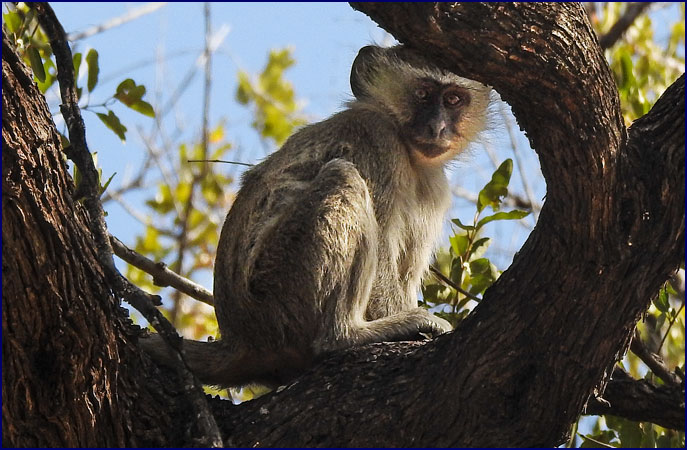|
We got the call that the wild dogs
were up and moving, setting out to hunt. We hurried to where we
had last seen them. The afternoon light was fading and the dogs
were getting ready to hunt. They trotted along in single file, and
we followed them. They were lean and athletic, and very much
reminded me of my lurchers (greyhound crosses) at home. They
paused to scan the area for prey, standing backlit by the setting
sun. They were spectacular. Gee pulled the land cruiser up close,
and several of the dogs walked within feet of us. One big male
looked up into George’s eyes, and for a moment we had the
feeling that it might jump right into his lap.
The
wild dogs spread out in a fan as they moved silently through the
trees stalking a herd of impala. They quickened their pace,
effortlessly loping along, and we followed, picking up speed to
keep up with them. The land cruiser sped along the narrow dirt
roadway, and then off it as we cut across country. I was in the
kangaroo seat in the far back, getting airtime with every bump. We
could see the dogs in front of us, weaving in and out of the
trees; intent on the hunt they paid us no attention. Whenever we
lost sight of them Gee would somehow know where to find them
again. It was unbelievable – we were on a wild dog hunt! It was
like something out of National Geographic.
Suddenly
the dogs surprised a small herd of zebra; there were half a dozen
adults and one half-grown baby. The dogs spread out and partially
surrounded them. They paused, clearly trying to decide if they
should try to take one down.
‘Oh, look, here are some zebra, they look tasty,’ they
seemed to be saying. ‘But
is it too risky? Maybe we should just go after some impala, much
safer. But then again, the zebra
would be a bigger meal, and they are right here . . .’
Oh no, I can’t watch!
Nick asked us, ‘Team Dog or Team Zebra?’ Definitely
Team Zebra for me. I know the dogs have got to eat, but let them
eat impala!
The
dogs hesitated, undecided, as the zebra herd nervously milled
around in a cloud of dust. They seemed to be picking one out of
the herd to go after. But then the zebra stallion pinned his ears,
bolted forward and charged at the dogs. He kept himself between
them and his herd, darting back and forth aggressively, ready to
fight valiantly if needed. Gee told us that a zebra stallion will
fight to the death to protect his herd from predators. We could
see the dogs having second thoughts. ‘Wow
that zebra looks really mean. I know there are some impala around
here somewhere, let’s go find ‘em.’ The zebra stallion
had successfully stood the dogs off and protected his herd. It was
like a scene straight out of Planet Earth. Go Team Zebra!
The
dogs took off again and we lost sight of them as they entered a
dense patch of woods to our left. Gee turned in the opposite
direction and went down a lane to the right; we thought perhaps he
hadn’t seen which way they had gone. He stopped the land cruiser
on a narrow track in the trees and just waited - we were sure he
had lost them for good. But suddenly an impala came bursting out
of the underbrush like a rocket, flat out, simply flying - and
right on his heels was a wild dog in hot pursuit. The impala
crossed the road just inches in front of us, practically leaping
over the hood of the land cruiser, and in a flash he was gone.
Distracted by the vehicle inadvertently being between him and his
quarry, the dog pulled up, looked at us for a few moments, and
then trotted off to rejoin his pack. Gee was amazing - he had once
again known just where to stop to let the animals come to us.
We were driving down a track through thick forest when suddenly
Mary, riding shotgun, saw a leopard dart across the road and into
the underbrush. Stopping, in the dim light we could just barely
make out a dappled rump, crouching in the thicket. After a few
minutes the exquisite leopardess turned and faced us. She strolled
out from her hiding place and past the vehicle, walking as if she
was moving through the shadows of my imagination. She turned and
looked at us over her shoulder for a moment, and then quietly
vanished into the dusky forest.
By
now it was getting quite dark and a stiff breeze was blowing. Gee
explained that on windy days the lions and leopards have the
advantage because their prey’s scent carries further. We noticed
a lot of impala moving about; with the wind they don’t bed down
for the night as usual, but stay alert because they know the big
cats are out hunting. When we came out of the forest we caught up
with a few of the dogs returning from the hunt, and we watched
them in the light of the rising full moon.
Because
Khwai is a private reserve instead of a national park, the rules
are more relaxed. In addition to being able to go off road for
dogs and cats, night driving is allowed - so we didn’t have to
hurry back to camp at sunset. Gee swept the beam of his spotlight
from side to side as he drove, searching for the reflection of
eyes in the dark.
We passed a baby zebra, standing
all by himself. Where was his family? Didn’t they know the wild
dogs were on the prowl?
An
African scrub hare crouched in the bushes – we figured there was
a strong likelihood of him becoming somebody’s midnight snack.
An eagle owl flew over us - probably looking for scrub
hares.
This started a discussion; if a
rabbit is the worst animal
to be in Africa, what would be the best?
Somebody said elephant, but I’d hate to have to worry about
someone shooting me for my tusks. The lion was brought up, but
who’d want to have to stick their head inside a dead buffalo? I
said maybe a giraffe because they are so beautiful, and big enough
that not too many things hunt them - but Gee thought that was a
bad idea because of the lions. So I asked Gee which animal he would want to be, and his answer was ‘an angel.’ Hard
to argue with that.
|

Scrub Hare
|
Gee
stopped the land cruiser, turned off the engine and lights, and
told us to just listen. We might hear lions calling, he said, or
we might hear other animals. We sat silently, taking in the
magical African night. We could hear the wind in the leaves, and
the mocking laughter of hippos in the distance. Stars were shining
overhead and the full moon was bathing the bushveld in a light
strong enough to cast shadows. Soon we moved on, but I could
happily have sat there all night.
The
spotlight illuminated the shadowy form of a hyena running through
the bush, and we saw several hippos grazing in the marsh. Nick
mentioned he would like to see a bushbaby, and Gee responded,
‘That would be very, very good,’ meaning it was highly
unlikely. Gee stopped again for us to listen to the night, cutting
the motor and lights. This time we could hear a loud, constant
slurping and crunching noise; to our amazement it was the sound of
the hippos eating marsh grasses.
Back
in camp, we learned that the guys had some wildlife encounters as
well. Mosa had seen a leopard walk through camp shortly after
we’d left. Then later, just before sunset, an impala had come
flying right through the middle of camp, with a wild dog hot on
its heels.
We had another terrific dinner. We
were amazed at the variety of excellent dishes Mosa could cook in
the bush, including beautiful loaves of fresh bread and fancy
desserts.
The full moon bathed the bush in a
pale silvery light. We sat around the campfire, sipping wine and
talking about how amazing the day had been. We drew in closer
to the fire as the night air got chilly.
We could hear singing and chanting
coming from a neighboring camp, with kind of a primitive rhythm to
it. We had noticed that many of the nearby campsites were now
occupied, but we had seen very few other vehicles out game
driving. Gee said that many of the campers were probably
weekenders from Maun; people from this nearest large town often
come to camp and party but don’t necessarily go out driving in
the bush.
We made our way to our tent by the
light of glowing lanterns set along the path. The distant singing
continued on well into the night, as did the laughter of the
hippos.
August
1
We had listened to the hippos
laughing throughout the night, and heard the chuffing of lions in
the wee morning hours. We got to sleep in until seven! After
breakfast Gee took us out walking in the bush.
Mike and Mary stayed behind, and
the rest of us followed Gee out the back of the camp, past where
the zebras had been hanging out. The birds were singing and the
sky was a clear blue. It felt good to be out walking around; you
don’t always get a lot of exercise on safari. Although he took a
rifle along as a precaution, Gee’s walking safari was not geared
toward finding large animals; rather it was about showing us the
small things we would miss while driving, and teaching us about
the bush.
Gee showed us what is known as the
toothbrush tree, which local people use to clean their teeth. He
dug up the root of a small sapling, cleaned it off, and gave us
each a piece to chew. In addition to making our teeth feel clean,
the tannin in it turned our tongues orange! This tree is also used
to make the dye for the baskets. Next Gee picked some wild basil,
and had us rub some on our hands and clothes to mask our scent.
Animals roll in it for this purpose, both predators and prey. It
had a strong pleasant odor, like sage.
Walking through a large area of
dead trees, we wondered if a fire had gone through - but Gee told
us that the trees had been killed by the elephants. They like to
eat the bark of the camelthorn acacia trees, but when they strip
the bark off all the way around the trunk it kills the tree. Not
for the first time, I noted that elephants are poor
conservationists.
Gee showed us a bush covered
with orange flowers and told us it was cat’s claw, which is used
for family planning - girls take it to prevent conception. He
pointed out wild stock rose, which has yellow flowers in the
summer; the roots can be boiled for sexual stimulation, like a
natural Viagra. He explained that the jackalberry tree has fruit
in the winter and supplies food for many birds, as well as monkeys
and impalas. Then he found a wild cucumber root that had been dug
up by an elephant and gave us each a piece to taste; it was very
bitter but apparently the elephants love it. Gee said it is also
used to treat gonorrhea. I used the leftover toothbrush tree root
to get rid of the nasty taste in my mouth.
We got a lesson on the different
types of dung. The kudu droppings were very fine and crumbled to a
powder when crushed – the food of all ruminants passes through
several stomachs and is well digested. We also saw some very tiny
baby impala droppings. In contrast were the huge piles of elephant
dung everywhere, much courser, full of leaves and sticks.
|

Gee
|
Gee
told us a bit about the ‘cultural beliefs’ of his people. He
said that if we took the elephant dung to Maun people would buy
it. Elephants find and eat rare herbs which pass through the
system largely undigested, and many people believe that these
herbs offer powerful protection and good luck, particularly for
children. ‘Traditional Doctors’, which we might call witch
doctors, will ‘smoke’ a baby for protection by passing him
through the smoke of burning elephant dung.
Gee pointed out an elephant
footprint in the dust, so fresh that we could see the wrinkles and
texture of the skin. He sprinkled a little sand over the track to
show us what it would look like if it were a day old, and then a
bit more for two days. He told us that if you measure the
circumference of a front footprint and multiply it by 2 ½, that
will tell you approximately the height of the elephant that made
the print. We also found leopard and wild dog tracks on the dusty
ground, as well as numerous zebra and impala hoofprints. It was
likeThe Morning Report in
The Lion King.
We saw several of what Gee called
elephant bedrooms, big indentions in the ground where they had
slept. Elephants sleep lying down for about two hours per day.
They often use a termite hill as a pillow, and also to make it
easier to stand up.
At one point the air was suddenly
filled with raucous screams and bellows. At first I thought we
were hearing elephants nearby, but Gee told us the sounds were
made by baboons. A bit later we saw a troop of them walking across
the meadow. Overhead three types of vultures rode the air
currents; using his binoculars Gee identified them as the
lappet-faced,
hooded and white-backed varieties.
As we turned back toward camp
there was a sudden blur of motion, and we got a mere glimpse of a
leopard as it darted into the underbrush. Gee said that because we
were a group it had fled, but that if just one person had been
walking alone the leopard would likely have stalked him.
Returning
to camp after the walk, our group all climbed in the land cruiser
for a morning drive. We went down to the river looking for hippos.
A big bull elephant came for a drink, and then he slowly waded in
and crossed the river straight toward us. As he got closer it was
clear that we were in his intended path; Gee quickly moved the
vehicle out of his way and he passed about ten feet from us.
Continuing
along the river we saw a tiny malachite kingfisher. This beautiful
metallic blue bird is one of the smallest of the kingfishers, and
a real treat to see. A blacksmith lapwing flew bravely at the land
cruiser, attacking to protect her nest from perceived threats. An
anhinga stood by the shore, drying its outstretched wings. Down in
the reeds beside the water Gee spotted a shikra, a beautiful grey
dove-sized bird of prey with bright red eyes (formerly known as
the little sparrowhawk). This turned out to be Sally’s 1000th
lifetime bird! She was also up to 181 new ones for the trip.
|

Shikra |
We
passed a baby hippo out of the water, all alone; Gee said it must
be a boy. He explained that the mother hippo gives birth in the
weeds, and if she has a girl she takes her back to the group. But
if it’s a boy she leaves him hidden in the grass and only comes
back when it is time to feed him, because if the father finds the
male baby he will kill him to eliminate competition. The boys grow
up alone, but can later join a bachelor group.
Soon we saw more hippos, standing
along the shore or moving ponderously toward the water. They are
huge; the females weigh around 3000 pounds and the males can be
over two tons. They live to be around forty, and their skin gets
very damaged with age; we could see long scars and wounds on many
of them. They need to stay in the water most of the time for
protection from the sun.
We
passed an old elephant that looked very thin and poor; Gee said he
had probably gone through all six sets of teeth and now was having
trouble eating. Due to their inefficient digestive process,
elephants need to eat tremendous amounts of forage, at least 200
pounds per day. A group of banded mongooses scratched in the dirt
hunting for insects, busily scurrying to and fro. We stopped for
tea beneath a tree, with a herd of zebras nearby.
When
we returned to camp George discovered that the monkeys had taken
his comb, toothbrush and toothpaste, which he had accidentally
left by the washbasin on the porch of his tent. For safety reasons
we were not allowed to go outside of the camp, so Nick, who wanted
to get in some marathon training time, ran something like 36 laps
around the tents.
The power strip in the land
cruiser was working only intermittently, so we had a bit of a
queue to plug in our camera battery chargers. Gee radioed to the
Letaka home office and they actually arranged to have a new power
strip flown in to us, which was pretty impressive - but it turned
out that the problem was in the wiring of the land cruiser itself.
But by taking turns plugging our chargers into the cigarette
lighter we were able to keep everyone’s batteries charged.
After lunch and a shower, we
watched two monkeys, an adult and a baby, leaping from branch to
branch in the tall trees above us. Gazing at the bigger one
through his binoculars, Nick commented, ‘Wow, that monkey’s
hair looks very well parted, and aren’t his teeth white!’
|

Vervet Monkey |
A
big bull elephant was browsing just behind camp, about 100 feet
from my tent. We watched him from the dining table. My camera was
in the tent, so I asked Gee if it was all right for me to go get
it - he said yes, but if the elephant decided to smash me there
would be nothing he could do! (Fortunately he didn’t.)
As I photographed the elephant he wandered closer to the
tent, passing less than 50 feet behind it. Perhaps he wanted to
use our bucket shower. How cool is that?
|